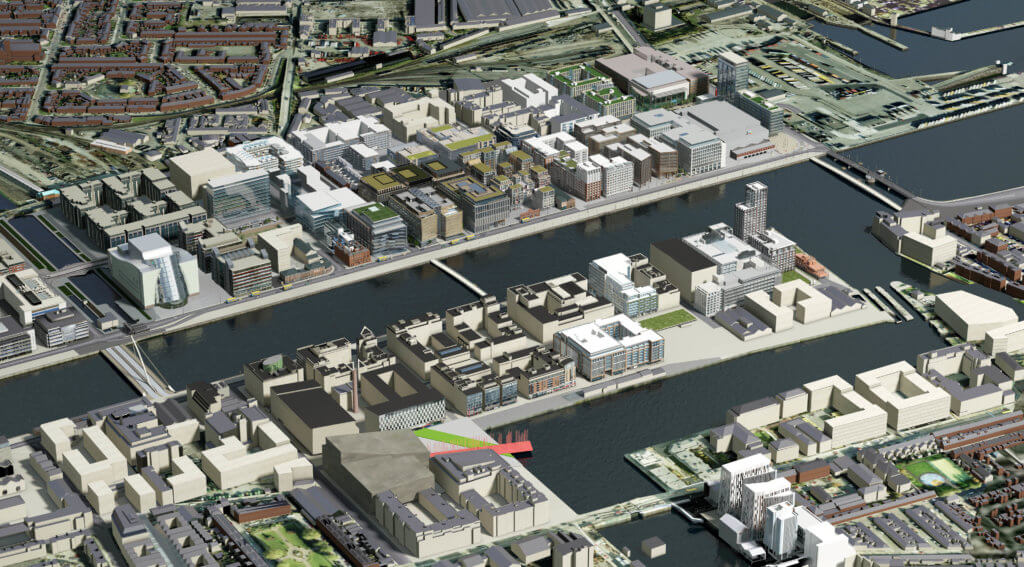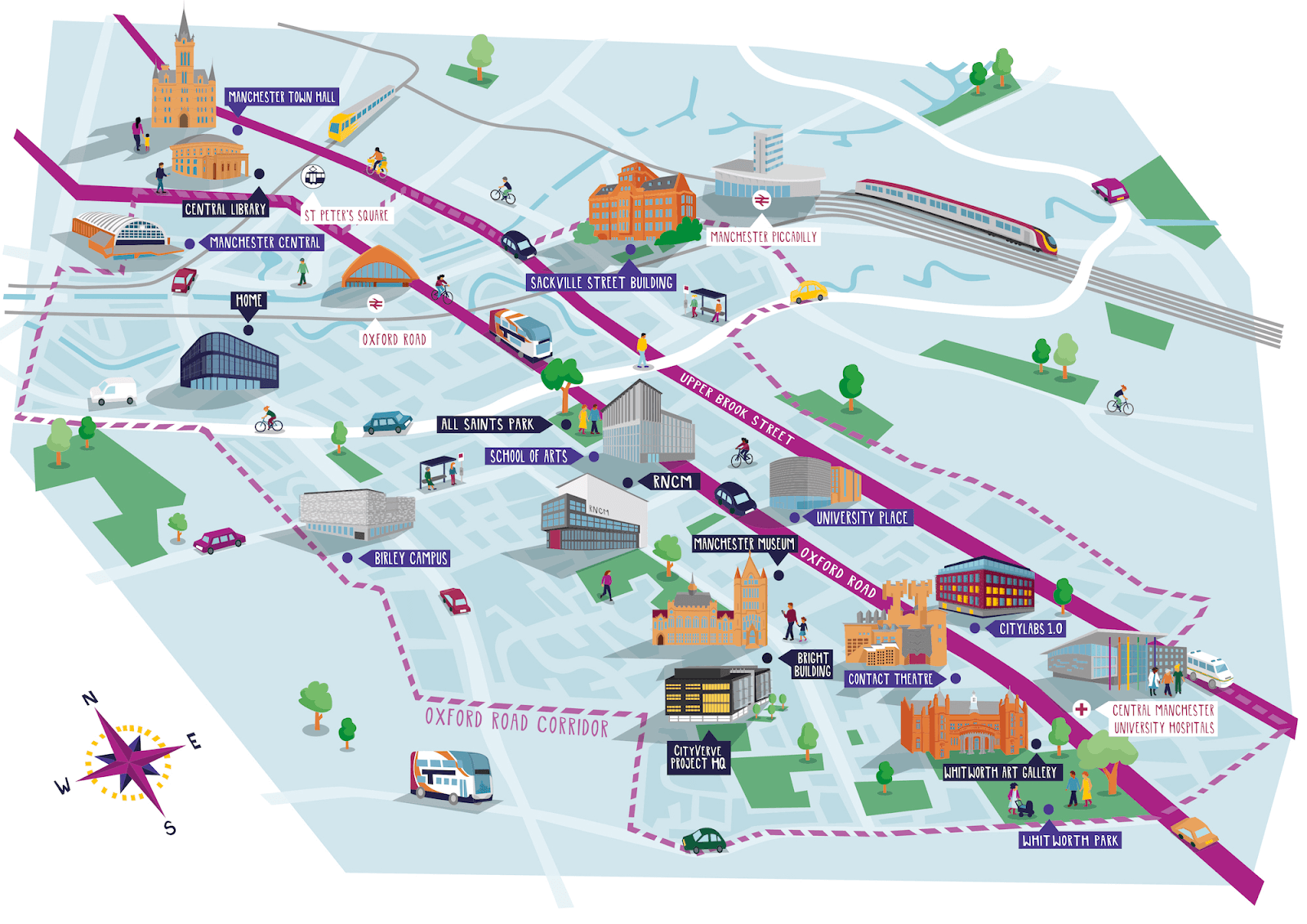
The concept of splitting a city into multiple districts in order to focus on the unique local requirements is not new. Today, as we see more and more cities using technology and innovation as a means to improve, there is also an increase in the creation of ‘innovation districts’ or ‘smart districts’. In this article, we hope to answer the question: What is the difference between an Innovation District and a Smart District?

Cities are often divided based on their socioeconomic characteristics, with the goal of responding to local needs and creating a sense of community. Many feature ‘Quarter’ in their name and can originate from religious influence in the area: Christian Quarter / Jewish Quarter – or more commonly the international influence on the area: Latin Quarter / Italian Quarter.
This developed further in the last century with many cities now featuring a ‘Central Business District’ (CBD) or ‘Financial District’, and most also including a ‘Historical/Heritage District’ and a ‘Downtown’ or ‘City Centre’.
Urbanization, however, has meant district boundaries are shifting as some areas become more desirable while other move in the opposite direction. In some cities, the difference in house prices can be as high as 50% within 1km of each other. This change has meant city leaders must adapt to ensure no area of the city is left behind.
A tactic we have seen from some cities over the last decade is the introduction of an ‘innovation district’ that promises to rejuvenate an underperforming or underutilized area of the city. The most high-profile of these has been the Sidewalk Labs project in Toronto. This project promised “a neighbourhood built from the internet up” resulting in “the most innovative district in the world”. In May 2020, however, the Google backed program announced that it would no longer go forward with its planned development (tentatively named Quayside) in Toronto’s Port Lands.
For those of us who work in urban innovation, these high-profile failures have cast a slightly negative light on an otherwise forward-thinking and fast-paced strategy used by civic innovators. Many of which have championed the ‘district approach’ may now find themselves fighting a battle with city management to continue with the approach.
But what is an ‘innovation district’ or a ‘smart district’? Are they the same thing? and have any proven to be successful?
Let’s start with the online definitions:
An ‘innovation district’ is defined by the Brookings Institute as a “geographic area where leading-edge anchor institutions and companies cluster and connect with startups, business incubators, and accelerators. They are also physically compact, transit-accessible, and technically-wired and offer mixed-use housing, office, and retail.”
A ‘smart district’ is defined as “a geographic area in which the city accelerates innovation through the use of rapid testing and trialling of solutions in order to solve city challenges. Often it provides the city with a platform to work with innovative startups in an agile environment”
Almost immediately you can see subtle differences in the scope of each type of district. But let’s highlight the specific differences:
- An ‘innovation district’ focuses on creating an ecosystem of innovators working on everything from MedTech to smart cities to FinTech. A ‘smart district’ is a more focused, subset of innovation districts that focuses specifically on urban challenges faced by citizens of that city.
- A ‘smart district’ has a focus on the physical built environment and often uses technology to improve the physical space, and innovation district encourages collaboration by increasing the density of innovators in an area.
- A ‘smart district’ is often led by the city authorities in partnership with academia and industry, an ‘innovation district’ is a wider community of innovators where the city and academia may or may not play a role.
- A ‘smart district’ often focuses on sense of place with the goal of improving the physical area, an ‘innovation district’, although geographically situated in one area, focuses on global innovation which cuts across many industries.
Taking all of this into account, the objectives of the city, when creating a smart/innovation district, is often a defining factor in its differentiation. An ‘innovation district’ has a primary focus on economic development and job creation whereas a ‘smart district’ has a primary focus on addressing urban challenges through the use of engagement and technology solutions.
This key characteristic is important to keep in mind when considering if your city is launching an ‘innovation district’ or a ‘smart district’. The two terms are often interchanged, but if one was to be critical, they are not interchangeable. It goes without saying there is innovation in a ‘smart district’ and ‘innovation districts’ should be smart, but they are two distinct entities.
Many cities also use the terms ‘living lab’ or ‘city lab’. For the most part, these refer to a ‘smart district’. However, if there was a scale from ‘living lab’ to ‘smart city’ they would be at opposing ends.
The example below demonstrates how many cities use smaller, more focused projects as a means to fast-tracking a full Smart City.
Back in 2018, The Technology and Entrepreneurship Center at Harvard (TECH) hosted a Smart City Accelerator in Dublin with a focus on ‘smart districts’. After two days of discussion, the city leaders in attendance compiled a set of principles which became “The Declaration of a Smart District”.
The principles defined a ‘smart district’ as one which:
- Is created and designed with and for the people that live and work in it.
- Respects communities, culture, and values.
- Encourages experiment and learning.
- Is empowered by the local government, but inspires globally.
- Enables effective use and access to data.
- Respects physical and digital privacy and champions security.
- Is transparent, fair, and inclusive.
- Is built on open standards.
- Is connected.
- Drives new economic opportunities.
- Is designed to scale – local to global, city by city.
- Supports local, national, and United Nations Sustainable Development Goals 2030.
While almost all of these principles could apply to any point on the ‘Smart City Growth Scale’ above, they are important in differentiating from a more general ‘innovation district’. The focus on connectivity and data to improve city life and services aligns with the ‘smart’ element of any city or districts.
To distinguish further here are some examples of the two districts.
Innovation Districts
Here East – London, England
“Here East is located in London’s Queen Elizabeth Olympic Park, we invite innovators, disruptors, visionaries and like-minded people to share – and participate – in the making of game-changing innovations. A model for change – Here East was designed from the outset to operate as a catalyst for change and a pillar of the post-Olympic East London community.
A dedicated campus, for innovators, disruptors, visionaries, and locals to push their professional and personal boundaries; to surround themselves with some of the world’s most inspiring artists and performers; to build on the Olympics’ architectural and cultural legacy. What makes Here East unique – Innovation, Education, Enterprise, Inspiration”

The Boston Waterfront Innovation District
When Boston Mayor Thomas M. Menino announced a new ‘innovation district’ in the Seaport District of the city he said “A new approach is called for on the waterfront, one that is both more deliberate and more experimental. Together, we should develop these thousand acres into a hub for knowledge workers and creative jobs.”
The goal was to accelerate the use of the district and encourage faster growth after large investments in transportation to the area. This has helped attract over 50 new businesses and 2,000 new jobs, a significant rejuvenation of the area.
Smart Districts
Smart Docklands, Dublin, Ireland
“Smart Docklands is a unique smart city testbed in the heart of Dublin’s Docklands. Established in 2018, it is funded by Dublin City Council and CONNECT Research Centre in Trinity College Dublin. It is a first of its kind in Ireland and globally, where the municipality and academia have funded a Project Management Office to play an ‘honest broker’ role amongst government, the tech and startup community, business owners, universities and research centers, and citizens of Dublin.

This innovative ‘quadruple helix model’ not only successfully engages collaboration between different stakeholders, but has secured strategic global partnerships with Google, IBM, AT&T, Accenture, Dense Air, Microsoft, Vodafone, Autodesk, Mastercard, Intel, and Softbank.
Smart Docklands successfully facilitates and enables the testing and trialling of smart city solutions by identifying real local challenges and working with diverse stakeholders to come up with lasting solutions in areas such as disruptive technology, environmental monitoring, waste management, and smart mobility.”
Their mantra is to avoid deploying “tech for tech’s sake”. Through their community engagement programme, they work closely with a diverse range of stakeholder groups including physical infrastructure companies, utility providers, property developers, building owners and local residents groups to identify challenges which can be addressed through new smart city technology and applications.
CityVerve, Manchester, England
“CityVerve brings together the brightest minds and pioneering uses of Internet of Things (IoT) technologies to redefine ‘smart’ in the context of a living, working city.

It aims to build and deliver a smarter, more connected Manchester, creating a city that uses technology to meet the complex needs of its people.”
CityVerve was based on 5 principles:
- An open platform to
- Identify opportunities by
- Enabling community involvement and
- Open innovation while using
- Rigorous Evaluation to assess if the desired result has been achieved and confirm whether it is commercially viable.
From these examples, you can see first hand the distinct differences. One has strong academic involvement and emphasis on solving urban challenges. The other is more focused on urban rejuvenation and economic development.
Can a city have more than one of these districts?
Can different types of districts coexist?
We have seen that many of these districts have led to significant economic growth, while others are solving local problems. One might question, however, how scalable this approach is.
A good example of expansion using smart districts is Smart Dublin’s strategic ‘districts approach’. They have five smart districts with different focus areas. One is a city centre testbed, another is an out-of-town business park, they are joined by a university campus, a heritage area, and a suburban town. Smart Dublin feels this distributed local approach will be a more targeted and efficient way of solving city challenges; while having the added benefit of diverse knowledge creation, which can be shared between district leaders.
Interestingly, Dublin’s Smart Docklands shares the same geographical footprint as an innovation district called the ‘Grand Canal Innovation District’. Two initiatives with distinctly different objectives, however, they coexist in the same location. At times they collaborate on community engagement however each has a separate agenda and journey to go on.
The line is not as clear in Barcelona with their ’22@’ district which is often described as both a smart and innovation district.
So where does that leave us?
While there is a significant grey area between the two types of districts, there are differences that can help you define your strategy. If you ask yourself the questions below, you will be further along the journey:
- How involved is the city in the district project?
- Is the objective economic development or improving city services?
- Will there be engagement with citizens of the district?
- Will other industries such as MedTech and FinTech play a significant role in the district?
- Who is funding the district and what do they want to get out of it?
What do you think of our differentiation between innovation districts and smart district? Do you agree? Please let us know.


